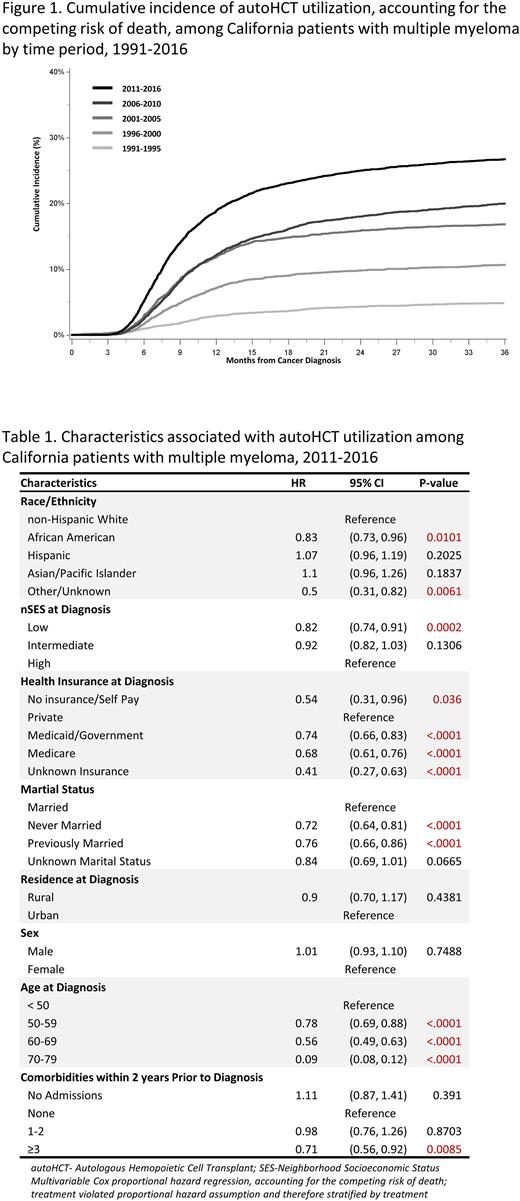Abstract
Introduction: Autologous hematopoietic cell transplant (autoHCT) is associated with improved overall survival for patients with multiple myeloma (MM), but utilization remains low. While MM disease characteristics and patient comorbidities inform the complex decision to proceed with autoHCT, race/ethnicity, neighborhood socioeconomic status (nSES) and health insurance have also been shown to strongly associate with use of autoHCT. Using a novel data linkage, we assess autoHCT utilization patterns over time and attempt to confirm previously seen associations between sociodemographics and access to transplant.
Methods: This retrospective cohort study used linked data between the California Cancer Registry (CCR), the Center for International Blood and Marrow Transplant Research (CIBMTR) and the California Patient Discharge Database (PDD). From the CCR, we identified patients ages 18-79 diagnosed with first primary MM between 1991 and 2016 that were linked to the CIBMTR or PDD (95.5% of eligible CCR patients). Use of autoHCT was ascertained from all three sources. We estimated the cumulative incidence of autoHCT after MM diagnosis and determined the association of sociodemographic factors with receipt of autoHCT using multivariable Cox proportional hazards regression. Secondary analyses assessed interactions of race/ethnicity, nSES, and health insurance by year of diagnosis. All analyses accounted for death as a competing risk.
Results: The cohort consisted of 29,109 MM patients with a median follow-up time of 10.2 years. Non-Hispanic White (NHW), Black/African American (B/AA), Hispanic, and Asian patients comprised 57%, 14%, 20% and 9% of the cohort, respectively. Overall, 18.9% of patients (n=5500) underwent an autoHCT. Median time from diagnosis to transplant was 9.7 months (interquartile range: 6.9-16.2). The CIBMTR captured 70.8% of autoHCTs (17.8% all three sources, 36.7% CIBMTR and PDD, 10.2% CIBMTR and CCR, and 6.1% CIBMTR only); the remaining autoHCTs were captured from PDD only (19.0%), CCR only (4.7%) or PDD and CCR (5.5%). The cumulative incidence of autoHCT at 12 months increased in recent time periods (Figure 1).
During 1991-2016, compared with NHW patients B/AA patients were less likely to undergo autoHCT (adjusted Hazard Ratio [HR] and 95% confidence interval [CI] (HR: 0.79, CI: 0.72 - 0.86) while Hispanic and Asian patients had similar utilization of autoHCT. Those residing in low nSES (HR 0.77, CI: 0.72 - 0.82)) or intermediate nSES ((HR 0.86, CI: 0.80 - 0.92)) versus highest nSES and those covered by Medicaid (HR 0.69, CI: 0.64 - 0.76) or Medicare (HR 0.83, CI: 0.78 - 0.89) compared to private insurance were also less likely to undergo autoHCT. Furthermore, findings indicate interactions of year of diagnosis with race/ethnicity (p for interaction <0.001), nSES (p <0.001) and health insurance (p =0.001). In models stratified by time period, Hispanic (HR 0.63, CI: 0.41 - 0.97) patients were less likely to have an autoHCT than NHW patients in 1991-1995, but less so in later years. B/AA patients had lower utilization throughout the study period, particularly after 2005. The differences for patients residing in the lowest versus highest nSES became less pronounced over time, with the strongest association observed in 1991-1995 (HR 0.38, CI: 0.26 - 0.56). Patients with Medicare were less likely to undergo autoHCT after 2006, while patients with Medicaid were less likely to undergo autoHCT over the entire study period. Multivariable models restricted to the 2011-2016 time period are presented in Table 1.
Conclusion: This is the first study to evaluate autoHCT utilization and sociodemographic factors in MM over time. Despite increased overall utilization, we found that B/AA patients were less likely than NHW patients to receive autoHCT with no change over time. Contrary to prior studies, Hispanic patients were less likely to undergo autoHCT only in the earliest era. We also observed that patients residing in the lowest nSES neighborhoods were less likely to utilize autoHCT, but differences decreased over time. Finally, those with public funded health insurance were less likely to undergo autoHCT. Additional studies are needed to further identify barriers to autoHCT utilization, particularly in B/AA patients and those with public health insurance. Identifying and mitigating these barriers is essential to ensuring greater and more equitable access to this highly effective therapy.
Disclosures
Wun:GBT, Inc.: Membership on an entity's Board of Directors or advisory committees. Rosenberg:Takeda: Other: Institutional Research; Kangpu: Other: Institutional Research; Bristol Myers Squib: Research Funding; Adaptive: Consultancy; Janssen, Takeda: Speakers Bureau. Meyer:Genzyme: Other: Study. Keegan:GRAIL: Other: Cancer Survivorship Advisory Board Meeting.
Author notes
Asterisk with author names denotes non-ASH members.


This feature is available to Subscribers Only
Sign In or Create an Account Close Modal